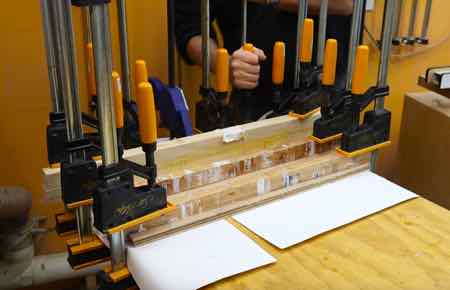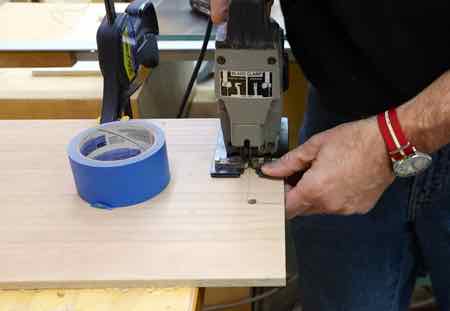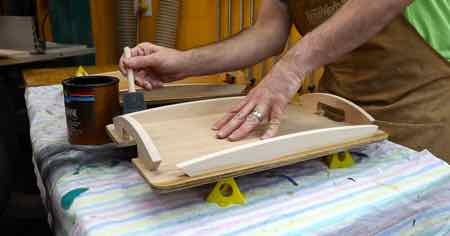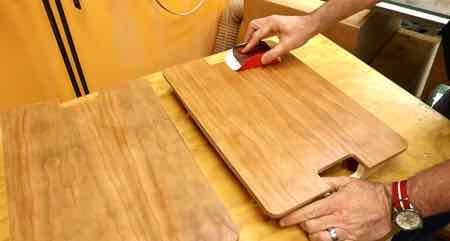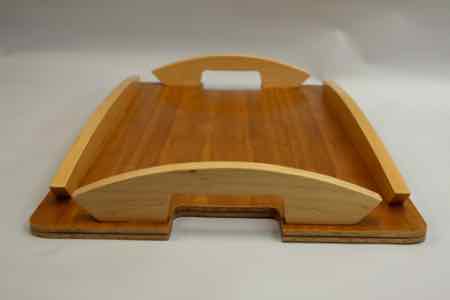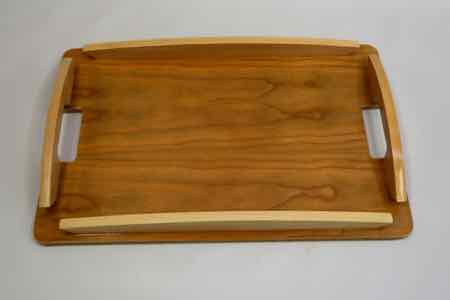PLANS FOR THIS PROJECT:
If you are interested in building your own version of this tray, I have a set of easy plans with 1:1 traceable templates available for purchase for a modest price. Your purchase is appreciated!
Read More... »The tray on the right was built over 40 years ago in my seventh grade shop class. The tray on the left was just built in present day.
The shop-class tray is one of the first real woodworking projects that I ever built. It has stood the test of time, given that it has seen regular use during those intervening 40 years. As well, it has some classic mid-century-modern stylings.
Finally, it is a very good beginner's project. There is NO ACTUAL JOINERY. This tray is made by just gluing four pieces of wood to a nice piece of plywood. The handles and sides do not touch each other. You could change the look of the handles also, and it would still be pretty similar to build.
I started by first taking measurements off of the tray and using that to draw the tray in sketchup. I then exported 2D drawings of the individual pieces, and brought those into the Woodgears BigPrint program. I then could add gridlines and generate simple, traceable, 1:1 plans. Those are available at the links above, if you want to try making this yourself.
The original tray was made with mahogany(?) veneer plywood. I decided to go the cheap route and used some leftover cherry plywood that I had. The problem was that this was only Good-One-Side plywood. (This means that the plywood only has one nice face for show, and the other face is meant to be hidden. The "bad" side is not even cherry veneer.) The plywood was also fairly curved. Gluing the plywood to the tray handles and sides should take care of most of the curve, but so will what I did next.
I cut out two pieces of plywood, somewhat oversized, and slathered their "bad" sides with glue and then stuck the two pieces together. I repeated that with another two pieces of plywood. If both worked out, I would have the material for two trays.
... I then clamped the two plywood assemblies to my flat assembly table. I used clamping cauls to apply clamping pressure to the center of the pieces. I clamped both sets at once.
The idea is that gluing two oppositely-curved pieces together, and clamping it to a flat table while it dries, will give result in a relatively flat piece of plywood that has a good cherry face on both sides. This worked quite well. After letting it dry overnight, both pieces of plywood were pretty flat.
I used the 1:1 plans to trace out the corner curves and the handle cutout onto both ends of the tray bottom.
Back in shop class we used scroll saws to do all the cutting. I'm not particularly fond of my scrollsaw so I used the bandsaw to cut out one tray, and I used a handheld jigsaw to cut out the other one. I wanted to prove to myself that it would work with a jigsaw, since I am positioning this as a beginner project. I also used my homemade disc sander to round the corners. You could also use a random-orbit sander for this step.
I next printed out more 1:1 plans for the handles and sides. I used spray adhesive to stick them lightly to some half inch (12.5mm) maple stock. The original tray used pine for the handles. I like to put cherry and maple together in projects. You can use hardwood or softwood here, as you like.
The handles were then cut out and sanded smooth. (I used my bandsaw to cut them out, but the jigsaw would also work. I wouldn't recommend a scrollsaw for maple that is this thick.)
I recommend just hand-sanding the plywood. I'm concerned that using a random-orbit sander would too easily gouge through the cherry veneer.
(next two photos) I cut out some scrap 1/2" (12mm) plywood and used that to help position the sides when gluing them to the tray base. This just helps give them a consisten offset. I layed the tray bases on my flat assembly table, right at the corner, and then glued and clamped the side and handle to the plywood tray base. The flat assembly table helps to ensure that the tray is totally flat when it is glued together. Since the tray is positioned at a corner, I could only glue two sides at a time. I simply waited a few hours and then came back and flipped the tray around before gluing on the other two pieces.
I used a foam brush to apply a coat of waterbased polyurethane. There are a lot of nooks and crannies on this piece, so it would probably be a lot easier to spray a finish, if you are so inclined. However, it is definitely possible to just simply brush on a finish.
I used a waterbased finish, which means that the first coat of finish will raise the grain. I very lightly sanded the piece with some 220 grit sandpaper after the first coat of finish. I then cleared off all the dust before applying the second coat of finish. After the second and third coat of finish I again sanded the piece very lightly, this time with 400grit finish. I applied four coats of finish in total.
It is very important to sand between coats, if you want a smoother finish.
Here are some finished photos of the finished trays.
Full Disclosure: The veneer on modern plywood is VERY thin, and I did have a few spots on the bottom of the trays where the veneer chipped out. But then again, so did the original tray that I made back when I was 11 years old. My parents never cared! As a beginner project, I consider it entirely acceptable.
If you are not a beginner, then you might consider using baltic birch plywood for the tray bottom and glueing on your own (thicker) veneer. There are many ways to do it.
thanks for stopping by!
Some of the Tools/Supplies Used In This Project: (Affiliate Links)
3M Super 77 Spray Adhesive
Minwax Oil-Modified Polyurethane
Irwin Quick Grip XP600 Clamps
Jorgensen Light Duty 4in Clamps
Jorgensen Light Duty 6in Clamps
Delta BOSS Spindle Sander
As an Amazon Associate I earn from qualifying purchases you make using my affiliate links.



